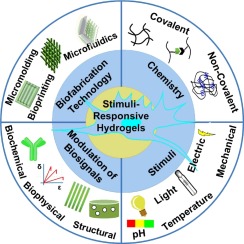Progress in Polymer Science ( IF 26.0 ) Pub Date : 2019-08-12 , DOI: 10.1016/j.progpolymsci.2019.101147 Mohamed Alaa Mohamed 1, 2 , Afsoon Fallahi 3, 4, 5 , Ahmed M A El-Sokkary 2 , Sahar Salehi 6 , Magda A Akl 2 , Amin Jafari 1 , Ali Tamayol 7 , Hicham Fenniri 8 , Ali Khademhosseini 9, 10 , Stelios T Andreadis 1 , Chong Cheng 1

|
Native tissues orchestrate their functions by complex interdependent cascades of biochemical and biophysical cues that vary spatially and temporally during cellular processes. Scaffolds with well-tuned structural, mechanical, and biochemical properties have been developed to guide cell behavior and provide insight on cell-matrix interaction. However, static scaffolds very often fail to mimic the dynamicity of native extracellular matrices. Stimuli-responsive scaffolds have emerged as powerful platforms that capture vital features of native tissues owing to their ability to change chemical and physical properties in response to cytocompatible stimuli, thus enabling on-demand manipulation of cell microenvironment. The vast expansion in biorthogonal chemistries and stimuli-responsive functionalities has fuelled further the development of new smart scaffolds that can permit multiple irreversible or reversible spatiotemporal modulation of cell-directing cues, thereby prompting in-depth studies to interpret the decisive elements that regulate cell behavior. Integration of stimuli-responsive hydrogels with current biofabrication technologies has allowed the development of dynamic scaffolds with organizational features and hierarchical architectures similar to native tissues. This review highlights the progress achieved using stimuli-responsive hydrogels in fundamental cell biology studies, with particular emphasis on the interplay between chemistry, biomaterials design, and biofabrication technologies for manipulation of cell microenvironment.
中文翻译:

用于操纵细胞微环境的刺激响应水凝胶:从化学到生物制造技术
天然组织通过复杂的相互依赖的生化和生物物理线索级联来协调它们的功能,这些级联在细胞过程中在空间和时间上发生变化。已经开发出具有良好结构、机械和生化特性的支架来指导细胞行为并提供对细胞-基质相互作用的洞察力。然而,静态支架往往无法模仿天然细胞外基质的动态性。刺激响应支架已成为捕获天然组织重要特征的强大平台,因为它们能够响应细胞相容性刺激而改变化学和物理特性,从而实现细胞微环境的按需操作。双正交化学和刺激响应功能的广泛扩展进一步推动了新型智能支架的开发,这些支架可以允许对细胞定向信号进行多重不可逆或可逆时空调节,从而促进深入研究以解释调节细胞行为的决定性因素. 刺激响应水凝胶与当前生物制造技术的整合已经允许开发具有类似于天然组织的组织特征和层次结构的动态支架。这篇综述重点介绍了在基础细胞生物学研究中使用刺激响应水凝胶取得的进展,特别强调了化学、生物材料设计和生物制造技术在操纵细胞微环境方面的相互作用。











































 京公网安备 11010802027423号
京公网安备 11010802027423号